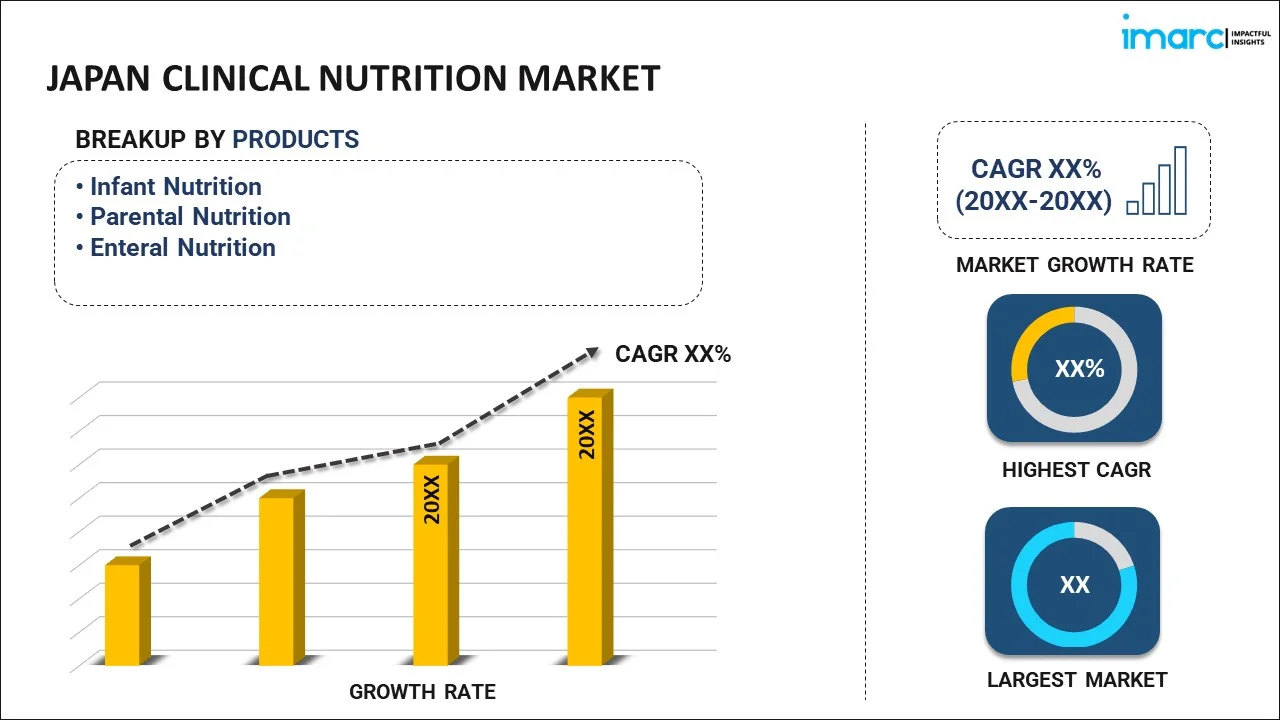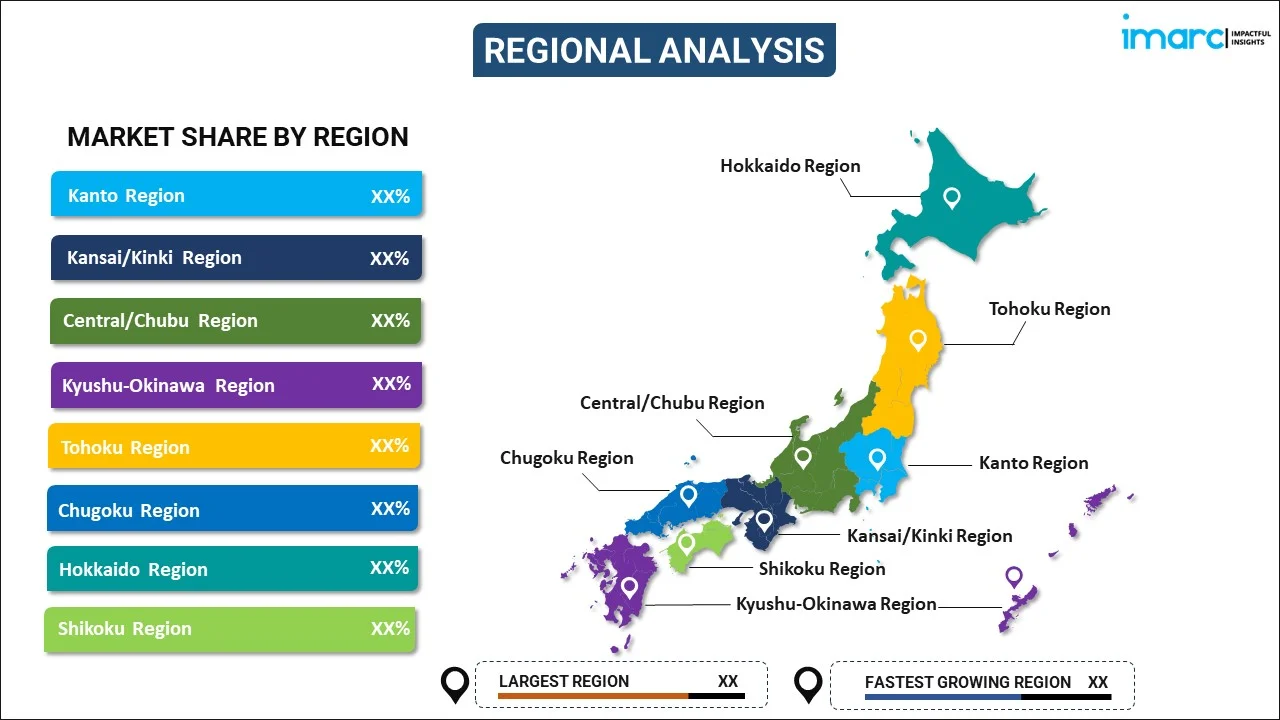
Japan Clinical Nutrition Market Report by Product (Infant Nutrition, Parental Nutrition, Enteral Nutrition), Route of Administration (Oral, Enteral, Parenteral), Application (Cancer, Malnutrition, Metabolic Disorders, Gastrointestinal Disorders, Neurological Disorders, and Others), End User (Pediatric, Adults, Geriatric), and Region 2025-2033
Market Overview:
Japan clinical nutrition market size reached USD 2,084.6 Million in 2024. Looking forward, IMARC Group expects the market to reach USD 3,433.2 Million by 2033, exhibiting a growth rate (CAGR) of 5.42% during 2025-2033. The inflating need for personalized nutrition that can be tailored to the needs of the individual, along with the widespread adoption of immunity-boosting alternatives, is primarily driving the market growth.
|
Report Attribute
|
Key Statistics
|
|---|---|
|
Base Year
|
2024
|
|
Forecast Years
|
2025-2033
|
|
Historical Years
|
2019-2024
|
|
Market Size in 2024
|
USD 2,084.6 Million |
|
Market Forecast in 2033
|
USD 3,433.2 Million |
| Market Growth Rate 2025-2033 | 5.42% |
Clinical nutrition is a distinct area within the field of nutrition science, concentrating on the management of diseases through the application of medical nutrition therapies. It encompasses the diagnosis and prevention of nutritional and metabolic conditions linked to chronic disorders arising from insufficient essential nutrients. Various types of clinical nutrition are available, including infant nutrition, enteral nutrition, and parenteral nutrition. In addition to this, the practice of clinical nutrition yields several advantages, such as mitigating the effects of malnutrition, improving responses to disease treatments, boosting immune levels, and enhancing digestive capabilities. Consequently, it is gaining extensive popularity across the region.
Japan Clinical Nutrition Market Trends:
The increasing prevalence of metabolic disorders, which elevate the risk of conditions like obesity, high blood pressure, and abnormal cholesterol levels, serves as a primary driver for the Japan clinical nutrition market. Furthermore, the expanding geriatric population, prone to chronic gastrointestinal ailments, fuels the demand for clinical nutrition in home healthcare settings, which is acting as another significant growth-inducing factor. Apart from this, the rising number of preterm births, coupled with the growing need for clinical nutrition in pediatric medicine, contributes significantly to market growth. Continuous advancements in healthcare infrastructure and government awareness programs promoting the accessibility of clinical nutrition for disease management are key factors in this expansion. Additionally, there has been a notable surge in demand for immunity-boosting alternatives, including clinical nutrition, to mitigate the risk of coronavirus infection, which is catalyzing the market growth across Japan. Besides this, clinical nutrition plays a crucial role in treating acute malnutrition, addressing protein deficiency, and enhancing immune defenses in patients, thereby augmenting the regional market. Noteworthy innovations in clinical nutrition solutions, such as optimized lipid emulsions and the introduction of liquid oral clinical nutrition formulas, are anticipated to drive the market in Japan over the forecasted period.
Japan Clinical Nutrition Market Segmentation:
IMARC Group provides an analysis of the key trends in each segment of the market, along with forecasts at the country level for 2025-2033. Our report has categorized the market based on product, route of administration, application, and end user.
Product Insights:

- Infant Nutrition
- Parental Nutrition
- Enteral Nutrition
The report has provided a detailed breakup and analysis of the market based on the product. This includes infant nutrition, parental nutrition, and enteral nutrition.
Route of Administration Insights:
- Oral
- Enteral
- Parenteral
A detailed breakup and analysis of the market based on the route of administration have also been provided in the report. This includes oral, enteral, and parenteral.
Application Insights:
- Cancer
- Malnutrition
- Metabolic Disorders
- Gastrointestinal Disorders
- Neurological Disorders
- Others
The report has provided a detailed breakup and analysis of the market based on the application. This includes cancer, malnutrition, metabolic disorders, gastrointestinal disorders, neurological disorders, and others.
End User Insights:
- Pediatric
- Adults
- Geriatric
A detailed breakup and analysis of the market based on the end user have also been provided in the report. This includes pediatric, adults, and geriatric.
Regional Insights:

- Kanto Region
- Kansai/Kinki Region
- Central/ Chubu Region
- Kyushu-Okinawa Region
- Tohoku Region
- Chugoku Region
- Hokkaido Region
- Shikoku Region
The report has also provided a comprehensive analysis of all the major regional markets, which include Kanto Region, Kansai/Kinki Region, Central/ Chubu Region, Kyushu-Okinawa Region, Tohoku Region, Chugoku Region, Hokkaido Region, and Shikoku Region.
Competitive Landscape:
The market research report has also provided a comprehensive analysis of the competitive landscape. Competitive analysis such as market structure, key player positioning, top winning strategies, competitive dashboard, and company evaluation quadrant has been covered in the report. Also, detailed profiles of all major companies have been provided.
Japan Clinical Nutrition Market Report Coverage:
| Report Features | Details |
|---|---|
| Base Year of the Analysis | 2024 |
| Historical Period | 2019-2024 |
| Forecast Period | 2025-2033 |
| Units | Million USD |
| Scope of the Report | Exploration of Historical Trends and Market Outlook, Industry Catalysts and Challenges, Segment-Wise Historical and Future Market Assessment:
|
| Products Covered | Infant Nutrition, Parental Nutrition, Enteral Nutrition |
| Routes of Administration Covered | Oral, Enteral, Parenteral |
| Applications Covered | Cancer, Malnutrition, Metabolic Disorders, Gastrointestinal Disorders, Neurological Disorders, Others |
| End Users Covered | Pediatric, Adults, Geriatric |
| Regions Covered | Kanto Region, Kansai/Kinki Region, Central/ Chubu Region, Kyushu-Okinawa Region, Tohoku Region, Chugoku Region, Hokkaido Region, Shikoku Region |
| Customization Scope | 10% Free Customization |
| Post-Sale Analyst Support | 10-12 Weeks |
| Delivery Format | PDF and Excel through Email (We can also provide the editable version of the report in PPT/Word format on special request) |
Key Questions Answered in This Report:
- How has the Japan clinical nutrition market performed so far and how will it perform in the coming years?
- What has been the impact of COVID-19 on the Japan clinical nutrition market?
- What is the breakup of the Japan clinical nutrition market on the basis of product?
- What is the breakup of the Japan clinical nutrition market on the basis of route of administration?
- What is the breakup of the Japan clinical nutrition market on the basis of application?
- What is the breakup of the Japan clinical nutrition market on the basis of end user?
- What are the various stages in the value chain of the Japan clinical nutrition market?
- What are the key driving factors and challenges in the Japan clinical nutrition?
- What is the structure of the Japan clinical nutrition market and who are the key players?
- What is the degree of competition in the Japan clinical nutrition market?
Key Benefits for Stakeholders:
- IMARC’s industry report offers a comprehensive quantitative analysis of various market segments, historical and current market trends, market forecasts, and dynamics of the Japan clinical nutrition market from 2019-2033.
- The research report provides the latest information on the market drivers, challenges, and opportunities in the Japan clinical nutrition market.
- Porter's five forces analysis assist stakeholders in assessing the impact of new entrants, competitive rivalry, supplier power, buyer power, and the threat of substitution. It helps stakeholders to analyze the level of competition within the Japan clinical nutrition industry and its attractiveness.
- Competitive landscape allows stakeholders to understand their competitive environment and provides an insight into the current positions of key players in the market.
Need more help?
- Speak to our experienced analysts for insights on the current market scenarios.
- Include additional segments and countries to customize the report as per your requirement.
- Gain an unparalleled competitive advantage in your domain by understanding how to utilize the report and positively impacting your operations and revenue.
- For further assistance, please connect with our analysts.
 Inquire Before Buying
Inquire Before Buying
 Speak to an Analyst
Speak to an Analyst
 Request Brochure
Request Brochure
 Request Customization
Request Customization




.webp)




.webp)












